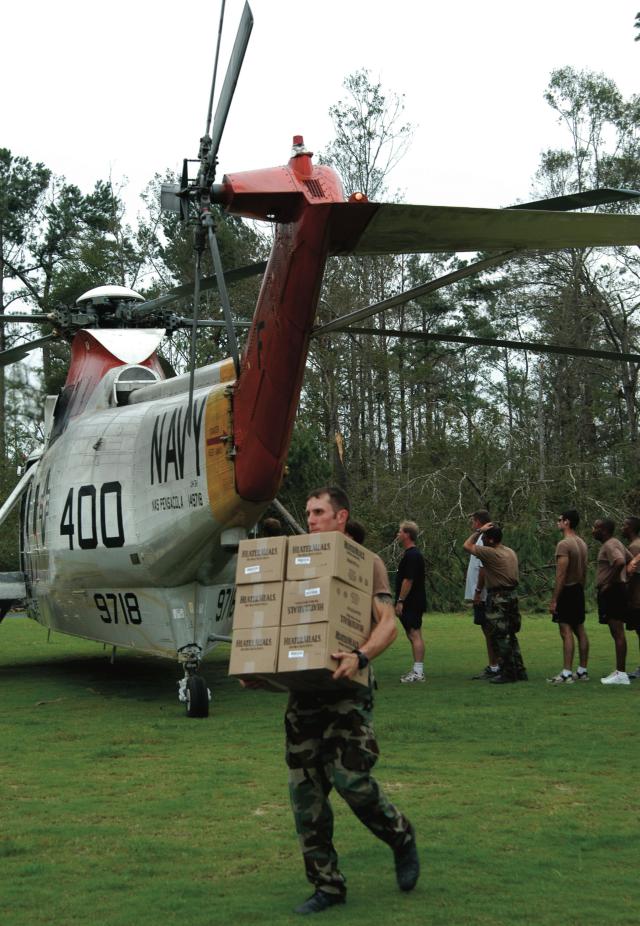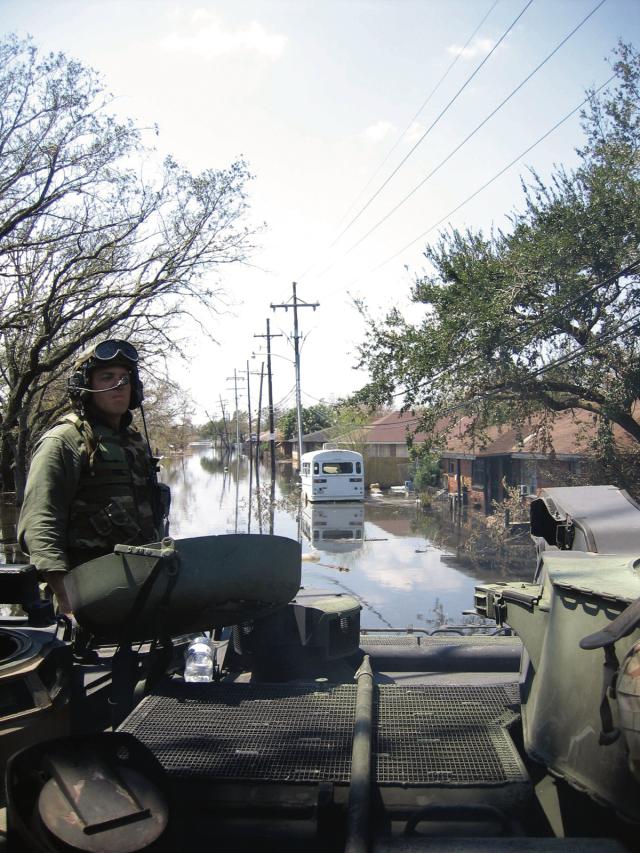At press time, the Sea Services continued to respond to Hurricane Katrina's destruction-and a tough Army general named Russel Honore has assumed overall military command.
Coast Guard helicopter and boat crews led the way, while the capabilities of Navy amphibious vessels, air cushion landing craft, and Marine amtracs proved their worth along the battered coast-particularly in the flooded city of New Orleans, where the USS Iwo Jima (LHD-7) came alongside and President George Bush came aboard to spend the night. The hospital ship Comfort (T-AH 20) tied up in Pascagoula, Mississippi, where the new San Antonio (LPD-17) housed and fed shipyard workers.
Joe DiRenzo III, Chris Doane, Jennifer Zeldis, John Carrier, Frank Huffman-and the on-scene photographers who made these images-chronicle the Sea Services' role in rescue and relief efforts.
Semper Paratus
The Coast Guard
The 2 September editorial in the Norfolk Virginian-Pilot captured the drama: "Like guardian angels from on high, the Coast Guard's orange-and-white helicopters swooped in to pluck trapped residents from housetops, or chop through roofs to rescue those who had taken refuge in attics. Terrified victim after victim was hauled away, day and night, from the swirling waters into the safe arms of Coast Guard medics and rescue swimmers. In many cases, Coast Guard personnel strapped stranded residents to their bodies, and, dangling over a drowned world, were pulled through the air to waiting helicopters. . . .
"The word 'hero,' which used to be reserved for the extraordinary, has become mundane from overuse. But the actions of those searching through dangerous debris and devastating flood waters-and braving gunfire and arsonists-to rescue their fellow man are truly heroic."
Long before Hurricane Katrina made landfall, the Coast Guard was repositioning personnel and equipment for an immediate response. Many Coast Guardsmen involved in the search-and-rescue operations put aside very real personal concerns to answer the call. A Coast Guardsman remained with the New Orleans mayor's office during the storm and through the first week of the response. The District Eight staff office, whose command building is located a few blocks from the French Quarter in New Orleans, established an incident management team in St. Louis, and placed key staff members in response centers throughout the region-for maximum coordination with local officials.
Unlike most other federal agencies, the Coast Guard is a true first-response organization with statutory authorities and responsibilities that allow it to respond without waiting for a Stafford Act declaration or state request for assistance. In addition, the service's daily operations require it to interact with state and local authorities, and the interpersonal relationships and trust built through these interactions significantly enhance communication, coordination, and cooperation. These characteristics make the service very flexible, able to change direction and respond rapidly where needed. Reflecting the service's long history of saving lives in peacetime, Vice Admiral Thad Allen, Coast Guard Chief of Staff, assumed responsibility for on-site relief, replacing embattled FEMA head Michael Brown, who headed back to Washington and resigned.
The service-40,000 strong-is a light force well aware of its inability to provide the heavy lift required to sustain and evacuate large numbers of victims. As a result, it is well versed in joint/unified operations.
Rear Admiral Robert Duncan, the Eighth District Commander, flew from Houston with the initial response aircraft to get an overview of the devastation, establish response priorities, and direct the initial force positioning. He coordinated the response continuously with the state emergency operation centers and the political leadership of the stricken states.
More than one-third of the service's aircraft were operating in the disaster area, along with a vast array of its disaster and major incident response teams. The service must still maintain sufficient capability to conduct other search-and-rescue, maritime security, counter drugs and alien migration operations while ensuring that the Eighth District receives everything it needs to save lives and restore the maritime transportation system so vital not only to the nation's economy, but also to moving large volumes of relief supplies and evacuees.
The service has liaison personnel or coordination teams at key locations and agencies " throughout the region. The teams are proving essential to ensuring communication with the other responding organizations to achieve unity of effort. At the peak of the rescue effort, the Coast Guard was transporting 750 victims per hour by boat and 100 victims per hour by air. A few additional statistics, as we go to press, tell the story:
* Rescued and evacuated: 33,000
* Boats used: 125
* Aircraft (both USCG and USCG Aux): 76
* Reserves recalled: 74 officers and 359 enlisted
One of the greatest leadership challenges is ensuring that rescue crews do not overextend themselves; crewmen insisted they didn't need rest and could keep going.
Semper Fortis
The Navy
Within 24 hours, 28 Navy ships were prepared to get underway to aid the Hurricane Katrina relief efforts. Sailors on the USS Harry S. Truman (CVN-75) offered to go ashore in the worst hit areas and assist in anyway they were capable even before the carrier left Norfolk.
The Truman was one of 16 Navy ships on station in the initial efforts. The USS Iwo Jima hosted the president-and provided a space for Vice Admiral Alien to brief Vice President Dick Cheney (above). The USS Tortuga (LSD-46), USS Shreveport (LPD-12), USS Bataan (LHD-5), USS Whidbey Island (LSD-41) and USNS Pollux (T-AKR 290) also provided initial disaster relief and continue to operate as search and rescue platforms. In addition, the Tortuga is providing berthing for local law enforcement and the Bataan is supporting fly-away medical teams. The Iwo Jima is the command headquarters housing Joint Task Force Katrina. The USS Defender (MCM-2), USS Gladiator (MCM-11), USS Falcon (MHC-59) and USS Scout (MCM-8) are conducting survey operations south of New Orleans. The USS Grapple (ARS-53) is clearing obstructions in the waterways around Pascagoula, Mississippi. In order to continue round-the-clock assistance operations, HSV-2 Swift, USNS Arctic (T-AOE 8), and USNS Altair (T-AKR 291) are providing supplies to the ships. The large hospital ship USNS Comfort (T-AH 20) arrived in Pascagoula with a 500-person crew, mostly medical staff, 250 beds, and a full load of medical and general-purpose supplies. The Navy Seabees performed community recovery missions as well. They are building tent camps for displaced residents, delivering water, and providing transportation support. They have started the painstaking process of cleaning up some of the highways close to Lake Pontchartrain.
The Navy also had 63 aircraft from six different bases performing search and rescue operations alongside the Coast Guard.
Semper Fidelis
Marine Corps
Special Purpose Marine Air-Ground Task Force (SPMAGTF) Katrina out of Camp Lejeune, North Carolina, initially commanded by Colonel John Shook, ted the way for the Marines. The headquarters element of the 24th Marine Expeditionary Unit flew into the Belle Chase, Louisiana, Reserve Naval Air Station, ten miles southeast of downtown New Orleans on Saturday, 3 September. The initial complement of 80 Marines would grow to over 1,000 Marines by the end of the Labor Day weekend.
Roughly 700 Marines from the 1st Battalion, 8th Marine Regiment-commanded by Lieutenant Colonel James S. Alley-and Battery E, 2nd Battalion, 10th Marine Regiment departed Camp Lejeune on 3 September to provide the security element. They joined other Marines already on the Gulf Coast that day. The ground force is expected to augment local law enforcement and National Guard units in providing security for the civilian population and their property.
The East Coast Marines were soon joined by their fellow leathernecks from California. Elements of the 11th MEU deployed S September from MCAS Miramar. These , Camp Pendleton-based Marines will link up with the rest of the SPMAGTF, under the command of Major General Douglas V. O'Dell, the commanding general of the New Orleans-based Fourth Marine Division.
The task force's aviation component, which is continuing to grow, initially included 10 CH-S3E heavy-lift helicopters, two CH-46E medium-lift helicopters, three UH-1N utility helicopters, and dedicated KC-130F aerial refueler/transports. The UH-1Ns alone lifted more than 450 residents from rooftops and small pieces of high ground where they had taken refuge from the flooding caused by Katrina. Reserve helicopters are augmenting this force.
The Marine aviation contingent deployed from MCAS New River on 1 September and moved to Pensacola, Florida, before flying into New Orleans International Airport. The heavy-lift capabilities of the squadron's CH-53E's were first put to use in bringing several tons of bottled water and food to the recovery effort. The Marine CH53Es were among the first to begin bringing the mostly elderly and ill victims of the hurricane to the airport, where they received immediate medical attention. The squadron and its 120 Marines arrived Thursday, and helped augment other Marine Reserve air assets in the region.
Marine Service Support Group-24 (MSSG-24) deployed to New Orleans on board the Shreveport and the Whidbey Island with more than 250 Marines on 2 September.







